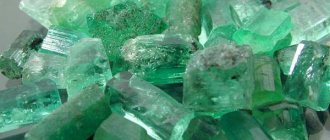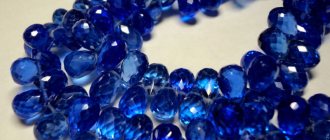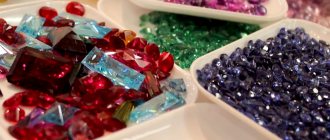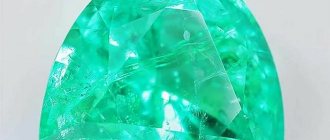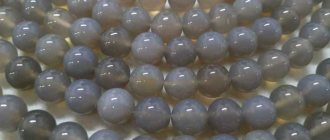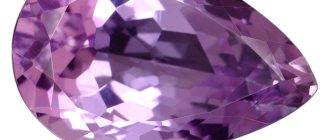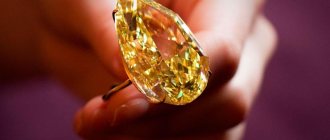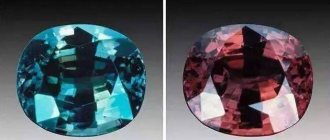Characteristics of green color
The ray of light itself has no color, but different colors “appear” in the eyes and brain of a person.
Scientists have found that each color spectrum corresponds to a certain wavelength of light and the speed of its vibration. Spectrum of light waves Red, blue and green are the three colors that the human eye perceives
Thus, green color is characterized by a length in the range of 530-490 millimicrons with a frequency of 590-650 billion vibrations per second. On the scale of all colors perceived by the human eye (from 400 millimicrons to 700) this is the middle. The technical side of the issue itself - how and why the human eye perceives light waves this way - has not yet been fully explored.
We see many plants, grass, forests as green, and therefore, for a long time, people have associated nature and everything connected with it with this color - life, harmony with nature, wisdom and peace.
The meaning of mineral color
Among natural green stones, there is a wide palette of green: from light to deep dark; with bluish, yellow, blue, gold, olive tints. A certain color and its gradations influence people both physically and spiritually, psychologically.
Green shades are associated with the central, heart chakra of a person, which is responsible for harmony and balance. Interaction with stones of this color range calms the nervous system, eliminates headaches, stimulates the treatment of infectious diseases, gives peace of mind, and has a beneficial effect on cardiac activity and blood pressure. In addition, with its help you can fight various fears, depression, and anxiety disorders.
From a psychological point of view of color perception, green is associated with nature, lush greenery, the tenderness of spring, life, joy, development and health.
For this reason, stones of this color help to feel unity with nature, safety, comfort and peace.
Therapeutic effect
The influence of green stones on humans is extremely positive:
- People have noticed that just looking at the lush greenery of a tree for a while is enough to rest your eyes and improve your mood.
- Yogis have established a connection between the green hue and the heart chakra. It heals mental wounds, normalizes heart rate and blood pressure. Headaches, including migraines, subside.
- Lithotherapists supplemented these observations by expanding the meaning of these minerals. For example, they have been found to protect against radiation.
Natural green stones strengthen the body as a whole, activating its reserves. The body works like a clock. Contemplating them improves vision.
Opaque minerals are considered particularly powerful healers.
Precious green stones
The very first thing that comes to mind when hearing the words “green stones,” of course, is emerald.
- Emerald is a type of beryl. The greenery of the mineral “provides” an admixture of chromium. It is the proportion of chromium that determines the individual characteristics of each stone. Vanadium can also play the “role” of chromium. Emerald differs from other beryls in its durability and transparency, and, of course, color. Therefore, identifying and distinguishing emerald from other precious stones is not difficult. If an emerald with a high mass has high characteristics in terms of purity and transparency, and also does not have any defects, then its price can reach unimaginable amounts. The most valuable emeralds in terms of their characteristics were discovered and mined in Colombia and Russia (in the Urals). This is a rather rare gem.
- Tsavorite (tsavorite) is a very rare gemstone on Earth. For comparison, finding tsavorite is several hundred times more difficult than finding a fairly rare emerald. There is only one known deposit of tsavorite - in Africa, near the Tsavo River. The name of the mineral was given based on marketing considerations. Tsavorite is a green variety of garnet, but the Tiffany jewelry company, represented by owner Henry Platt, came up with this move, thereby emphasizing the unusualness and value of the newly discovered mineral. The color range of tsavorite is wider than that of emerald; it can be from soft green, like young grass, to dark blue. The gem was discovered in the 60s of the last century and therefore cannot boast of stories about its use in ancient times or legends about its miraculous properties. However, it clearly has two properties that all green stones have - the ability to pacify and calm, and also to attract wealth.
Emerald
Tsavorite
Emerald
The most famous gemstone is green. By its nature, it is a type of beryl group. The rich color of fresh greens ensures a high content of chromium impurities in the mineral.
Assessing the color and quality of green gemstones
Gemologists evaluate color based on hue, hue, and saturation. In a green gemstone, the primary shade is green, but these gems often have secondary shades such as blue or yellow. Pure green is the most desirable (and most expensive). Most people prefer the blue tint of the stone to the yellowish green. Yellow-green gems are quite attractive, but do not bring profit.
This bright and vibrant green tourmaline has an attractive secondary blue hue. © Earth's Treasury
Green colors are most saturated or intense in medium-dark tones. Dark gemstones are more difficult to evaluate, while light gemstones look vibrant and attractive. Gemstones of bright and rich colors are the most desirable and expensive.
Clarity can be an important factor in the quality of a gemstone. Keep in mind that clarity is not only about clarity, but also about the presence of natural imperfections in the gemstone. They are generally less noticeable in dark gemstones than in light gemstones. However, avoid gemstones with large inclusions or cracks as they may be more susceptible to fracture. It is also easy to notice large or dark flaws in the center of the stone, so avoid gemstones with such flaws.
Emeralds are known for their poor clarity. This large natural emerald has many small flaws. © CustomMade
Semi-precious green stones
- Malachite. It is worth saying or thinking: “the green stone of the Urals” and then malachite may come to mind (and the mistress of the Copper Mountain, too). Malachite is a semi-precious ornamental stone, opaque, with a matte sheen. It has a wide range of colors - from light turquoise to dark green, with patterns and patterns. Patterns with stripes in a circle, reminiscent of the concentric rings of a tree, are especially appreciated. Malachite is considered a truly Russian stone, because huge deposits of it were found in the Urals. Previously, only aristocrats could afford jewelry and products with malachite, which is why it was called the “royal stone.” There are many beliefs and legends associated with malachite, because it has amazing magical powers. It is believed that malachite is the connection between the Universe and the Earth. And one cannot help but note the Ural legend, which says that if you constantly drink from a malachite cup, you will begin to understand the language of animals. Its magical properties depend on the complexity of the stone's pattern. The stronger the magic of malachite, the more complex the patterns. So those who want to take full advantage of the healing and magical powers of green stone should choose specimens with the most complex patterns.
- Serpentine (serpentinite) is a mineral with characteristic spots and dots, its appearance reminiscent of snake skin. Therefore, the Russian name is serpentine, and the scientific name is serpentinite, which is also due to the similarity and is translated from Latin as “snake stone”. This is magnesium silicate, the stone is not precious, but nevertheless, it is very loved and revered by many peoples of the world. Many legends and traditions are associated with it. He was especially revered by alchemists, pharmacists and astrologers. Coil is used to line walls and make many household items - boxes, vases, figurines. In the jewelry world, serpentine is used to make inexpensive jewelry, and is also used in lithotherapy and for magical rituals.
Coil
- Green sapphire is a type of corundum. Red corundums are usually called rubies, blue and blue shades are called sapphires. But green sapphire does not have a generally accepted separate name; it is often called “chlorine sapphire” or “Oriental emerald”. Refers to semi-precious stones. The purer and brighter the green color of the sapphire, the more iron impurities it contains. The presence of aluminum oxide impurities gives the mineral a gray-green tint, almost gray. The color of sapphire is determined, however, not by green inclusions, but by the presence and alternation of yellow and blue stripes. In appearance it is quite bright, reminiscent of tourmaline or peridot, but unlike red and blue corundum, it does not have such value and is inexpensive.
- Green jasper is a type of jasper, it is of volcanic origin and consists of almost 95% quartz. Green jasper has high artistic value, although it is quite widespread. Used for interior decoration, making household items, and jewelry. Using jasper, a master can show his artistic talent and create a work of art. It is green jasper that has unique healing and magical properties - it helps to heal from many diseases, prolong life and protect from troubles.
- Jade is a semi-precious ornamental stone sacred in China. It is distinguished by high strength and original weave of fibers. Green jade can be from light to swamp. Astrologers believe that jade affects not only a person’s physical condition, but also his spiritual thoughts. It helps to strengthen one’s faith and have higher thoughts. Develops logic and intellectual abilities, reveals human talents.
Nephritis
The division into precious and semi-precious stones is very arbitrary, and therefore it is difficult to determine exactly which class to classify the following types of green stones - tourmaline, demantoid (garnet), peridot and chrysoprase. According to one of the jewelry classifications, they are classified as the 4th (lowest) group of jewelry precious stones, but at present they are still considered semi-precious.
- Demantoid is a semi-precious stone with a rich grassy green color. It is a variety of garnet or andradite. Translated from Greek and German, the name of the stone means “diamond-like.” Its other name is “Ural emerald”. The gem is known and is especially popular in Russia; its deposit is located in the Urals. A special feature of the demantoid is the unusual play of light due to the strong refraction of rays. Demantoite was also found in Namibia, but in terms of color characteristics it is inferior to its Ural “brother”.
Demantoid
- Tourmaline - its green variety - is verdelite. The name verdelite comes from the Italian “verde” - green. The mineral has warm soft green shades, glassy luster, and sufficient hardness. It is transparent or semi-transparent, has a high refraction of light, which means it allows you to admire the beautiful play of rays and shades from yellow to green. It has a low price because it is quite widespread in nature and also has fairly large crystal sizes. It is also called "Brazilian emerald". Of the magical properties, the attraction of success and fame is inherent. It is because of these properties that verdelite is inlaid into many crowns - this is how government officials provided themselves with a talisman of success.
Verdelite
- Chrysolite is a semi-precious stone, a transparent variety of olivine, peridot, “evening emerald” (at dusk its color becomes more like emerald). Known to man for a very long time. Peridot was used by those involved in science or study because it was believed to help with concentration. Chrysolite also has the property of attracting wealth and good luck, removing troubles and envy from the owner. Psychics and astrologers love to use chrysolite - it helps not only to concentrate, but also to relieve stress, concentrate and thereby enhance clairvoyance.
Chrysolite
- Chrysoprase is a quartz gem, a variety of quartz and chalcedony with an admixture of nickel. The name chrysoprase means “gold and leek.” In fact, the color of chrysoprase also resembles the color of onions with a golden tint. Chrysoprase has a rich green color - from light to dark to blue-green. It has a fine-grained structure with a play of designs and patterns, for which it is especially valued by jewelers. Since ancient times, the stone has been very popular among the nobility and powerful people, and therefore is still associated with power and wealth. This is an amulet of traders, bankers, businessmen, that is, everyone who is in one way or another connected with trade.
Chrysoprase
- Aventurine is a “stone of luck” or “stone of opportunity.” This is quartzite with a fine-grained structure, translucent, interspersed with mica, hematite or others that give it a shimmer. Green aventurines are more uniform in color, unlike other shades of aventurines, they are also more durable. In ancient China, green aventurine was a sacred stone. Magical properties, in addition to bringing good luck in gambling endeavors, giving optimism, calming, and also “falling in love” with its owner. Associated with the heart chakra and bestows creative inspiration.
Aventurine
- Seraphinite is a miraculous mineral mined in only one place - in Siberia. Seraphinite or clinochlore is a complex silicate. It has shades from light green to olive, with fibrous inclusions of pinkish, pearlescent, lilac color. In appearance, the mineral resembles charoite. The uniqueness of seraphinite lies not only in its rare patterns, but also in its proven healing properties. Lithotherapists have confirmed through scientific tests that seraphinite promotes the healing of burns and wounds, promotes recovery after operations and has a number of other medicinal properties. Magicians and clairvoyants use the stone to immerse themselves in meditation or trance.
Seraphinite
Magical and healing properties of green stones
As can be concluded from the information provided, almost all green stones, regardless of whether they are precious or semi-precious, transparent or not, they bestow a person with well-being, peace of mind, and protect from troubles.
Bioenergeticists rightly believe that stones of the color of vegetation, eternity and nature increase the body’s defenses, soothe and treat the eyes, psyche and headaches. Please note that there are no green medications for the treatment of depression, this is explained by the fact that green increases vitality, lowers blood pressure, and promotes the regeneration of human tissue.
A symbol of spring, memories, life and joy - according to Catholic symbolism and ancient Indian philosophy.
Green is also highly revered in Muslim symbolism, and in Europe it is revered on a par with white and is the personification of the world of fairies and magic.
Tiara Vladimirskaya
Let us also note some inconsistency in the properties of green stones. As, indeed, are all colors and almost all stones. Thus, light green minerals can attract negative attitudes or thoughts, for example, this applies to opaque stones, you should be careful with them. And bright blue-green gems can contribute to the emergence of neurosis.
Ornamental green stones
This group is considered the most widespread on the planet in terms of the number of representatives. Stones of this class are used to make both jewelry and interior and household items.
Nephritis
A valuable mineral with a history of several thousand years. Belongs to the group of jads. It was from green jade that the imperial seals of China were most often made, so this mineral has special significance for the inhabitants of the Middle Kingdom.
Color variations range from onion green to emerald gray. Dark and white veins, dots, and small spots can be visible in the structure.
The main deposits are located in China, Canada, the USA, Kazakhstan and Russia (Tuva).
Interesting! In China, mini-figurines made of jade are very popular, representing any wish. For example, peach means longevity, and fish means wealth.
Chrysoprase
One type of chalcedony has a wide palette of shades: from light apple to green-blue. The stone is characterized by its rich color and is often used by jewelers in combination with silver or gold settings.
The light green tint results from the inclusion of nickel in the structure. The stone is mined in Australia, Brazil and Germany.
Amazonite
A mineral that has long been confused with jade. This is actually a cheaper type of feldspar. Often used in inlays, in the manufacture of interior items and jewelry.
The main deposits are located in the USA and Russia (Ilmen Mountains).
Onyx
This green stone is often used to make countertops, dishes, interior items and spectacular gift souvenirs. It is often confused with agate, however, the color of onyx is lighter and more diffuse. If there are brown inclusions, the mineral becomes like marble.
Mined in South America, Uruguay, Egypt, USA, Asia and Pakistan.
Aventurine
This type of quartz is presented in a gray-green shade. Opaque specimens are often set in silver and used to make inexpensive jewelry, dishes, vases and boxes.
The largest deposit is in India.
Important! Aventurine is the most often counterfeited. Cloudy glass or plastic is used as an imitation.
Green gemstones perfect for everyday wear
If you are looking for a great green gemstone for your everyday wear ring, the stones below are your best bet. Each one is rated at least 6.5 on the Mohs hardness scale, making them scratch resistant. They are also less likely to break if accidentally dropped or hit on a table. These durable green gemstones are suitable for everyday wear, making them ideal for engagement rings. With regular cleaning, they will look as good as the day you bought them.
Nephritis
By far, jade (as well as jadeite and its varieties) is the most durable gemstone in the world. You can hit it with a hammer without breaking it! In addition, this famous green gemstone is famous for its musical qualities: when struck, it rings like a bell. The beautiful clarity of jade has fascinated people for centuries, making it one of the world's most popular gemstones for cutting. However, avoid low quality processed jade. Inexpensive jade undergoes heavy processing and may have low strength.
These color-matched green jade carvings make attractive earrings. © The Gem Vault
Verdelite and chrome tourmaline
If you prefer a cut stone, consider green tourmaline, also known as verdelite. These gemstones can be larger and have better clarity than emeralds, as well as lower price and greater durability. Verdelite is a better choice as an alternative to emerald and is often emerald cut.
Due to their crystalline shape, most tourmalines have an elongated cut, like this beautiful sea green tourmaline. © The Gem Vault
A rarer stone with better color is chrome tourmaline. This gemstone is slightly more expensive than verdelite, but its rich green color is worth the extra cost. Its color comes from chromium, the same rare element that colors emeralds.
This chrome tourmaline center has a beautiful vibrant color with tsavorite accents. © Aharoni Jewelery
Green garnets: tsavorite and demantoid
If you prefer green gems with a strong sparkle, gemstones from the garnet family may be the best option for you. Although garnet is best known for its brownish-red hues, it comes in all colors, and green is the best choice. Green pomegranates go by different names depending on their chemical composition. Green grossular garnets can be deep colored tsavorites or lighter mint garnets. A favorite of many jewelers, tsavorite has a gorgeous color and can produce a lot of sparkle when cut correctly.
Green garnets of large size are rare, making this 5.09 carat tsavorite a unique centerpiece. © Aharoni Jewelery
Another, rarer variety of green garnet is demantoid. These garnets get their name, meaning “diamond-like,” from the intense flashes of color that can occur in the processed gemstones. Due to its chemical composition, demantoid is less common and is more expensive than other varieties. However, if you like the red flash from the depths of the green stone, you will fall in love with the demantoid.
Like many demantoids, this 2.53-carat Russian gemstone has a bright green color and prominent inclusions. © The Gem Trader
Heliotrope (bloodstone)
Bloody stone, and suddenly green? Heliotrope is a variety of chalcedony with a green body color and red spots that resemble blood. This gemstone is the traditional birthstone of March, and its association with blood has made it a symbol of courage for warriors going into battle.
This vintage statement ring features a dark green bloodstone with vibrant red flecks. © Market Square Jewelers
Green Diamond
If your budget allows, why not choose a green diamond? This is one of the rarest natural diamond colors, with green shades being especially interesting. They arise from nitrogen, hydrogen and nickel in the diamond's crystal structure or from defects caused by irradiation when the diamond forms underground.
This 0.57 carat green diamond is a great option for a unique engagement ring. © Pavé Fine Jewelry
If a natural green diamond is beyond your budget, consider a treated diamond. Irradiation can create excellent green gemstones at much lower costs. And don't worry, they are completely safe!
Matte sit-sit
If jade is out of your budget, consider matte sit-sit (jade albite). This green stone often has vibrant hues due to minor amounts of chromium as well as black inclusions, making it an excellent jade replacement. Interestingly, some jade albites contain jadeite. The combination of jadeite and clinochlore gives them a bright green hue. However, matte sit sit is available at a low price, making it a very attractive alternative.
The bold design of the ring perfectly complements the rich green matte sit sit. Design by Jorge Adeler. © Adeler Jewelers
Green chrysoberyl
The chrysoberyl mineral is best known as the classic yellow cat's eye gemstone. But did you know that it comes in green? Beautiful mint green chrysoberyls are found in several regions, but the market for these gemstones is small. However, well-cut green chrysoberyl has a wonderful luster and would make a great choice for a ring.
This light yellow-green chrysoberyl is perfect for a cocktail ring. © Market Square Jewelers
Chrysoprase
An unusual and attractive gemstone, chrysoprase is a type of chalcedony with inclusions of nickel-containing minerals that give it its bright green hues. This gem, polished or faceted, is another great jade lookalike. If you are looking for a stone that will last, make sure it is quarried in Australia. Chrysoprase from other regions may fade in the sun.
Vibrant translucent green chrysoprase drops make these earrings pop. © Pavé Fine Jewelry
Prasiolite
This light green variety of quartz has recently become a popular inexpensive jewelry stone. Green quartz is rare in nature, and gem dealers may heat treat light-colored amethyst to produce this gemstone. (Amethyst is a purple variety of quartz).
The central stone is pear-shaped prasiolite and has a natural pale green color. © Aharoni Jewelery
Green sapphire
The most famous is blue sapphire, but this stone also comes in green. Sapphire is a great choice for an everyday ring as it is one of the most durable gemstones. Olive green, mint green, and yellow green gemstones are more common than grass green gemstones. Green-blue mermaid sapphires are also popular. That being said, green gemstones are less popular than blue gemstones, which is why they are cheaper!
This stone has a mint green color, unusual for a Montana sapphire. © Earth's Treasury
Idocrase (vesuvianite)
In crystalline form, idocrase can be a beautiful cut gemstone. In its massive form it looks like excellent jade. Idocrase crystals are found in abundance in metamorphosed limestones near Mount Vesuvius, which is why some call the stone "vesuvianite." Although idocrase is an uncommon jewelry stone, it does not have major durability issues and can withstand daily wear.
Foggy idocrase of amazingly bright saturated color. © The Gem Trader
Aventurine
This variety of quartz has natural sparkles. Flat thin crystalline inclusions in the stone sparkle in the light. These minerals also make quartz bluish-green. With a hardness of 7, aventurine is certainly durable enough for everyday wear. (Keep in mind that the craft glass known as "goldstone" is also called "aventurine", but this material is different from quartz aventurine.)
This aventurine pendant features a rich green hue and lots of sparkle. © Mineral Miners
Bottle, light green, marsh, olive and other possible shades of green stones
The color range of green nuggets is extensive, as can be seen from the photo. This is explained by different types of impurities, which are often chemical elements such as chromium, manganese, iron, and titanium. The same nugget (for example, demantoid, alexandrite) can have several shades - from pale green and emerald to marsh, olive, sea green. It can be dark, light, almost transparent with a greenish tint. Some representatives of the “green family” may have other tones - yellow, black, pink, red, blue-purple.
Veins, stripes and other inclusions
The purity of precious and semi-precious minerals is assessed depending on the presence of defects and inclusions in their structure. The formations look like cracks, clouds, lines, spots or dots. They can have different colors and shapes and are visible to the naked eye or under a microscope. The presence of veins is normal for a naturally occurring mineral.
The inclusions give the nuggets their uniqueness. Upon purchase, each stone is accompanied by a list of defects and inclusions. If you need to prove that a piece of jewelry belongs to the owner, this can easily be done using the list of inclusions. The natural imperfections of stones are specific, and each of them can be accurately identified by them.
The magical properties of green stones
The wide variety of green semi-precious stones can make it difficult to identify a specific stone at first glance. However, knowing the different classifications of stones can help you determine this. You can often classify a stone based on visual characteristics, without the use of scientific equipment or testing. Write down any observations you make to compare with the classifications in your gemstone book. If the stone is similar to two different varieties of green semi-precious stones, you can continue testing or have a professional gemologist evaluate it.
Jewelry with green stones
Jewelry with a green gem is always an indicator of good taste and style. The owner of such jewelry receives a means to find peace and harmony. The variety of shades of green minerals allows you to choose jewelry for any occasion or use of magical and healing properties and at the same time look stylish and luxurious.
Earrings with emeralds
For a selection of photos of green minerals, watch the video:
Who are they suitable for?
Many of the stones are considered magical and are used as amulets, talismans and amulets. If you look at the signs of the zodiac, then:
- Green diamond, demantoid, uvarovite, emerald, turquoise, amazonite and gray-green lapis lazuli are suitable for Aries;
- Amazonite and serpentine are recommended for Taurus;
- Gemini should pay attention to alexandrite, beryl, malachite, jade, amazonite, chrysoprase and emerald;
- Cancer needs emerald, tourmaline, beryl, chrysoberyl, aquamarine, chrysoprase, peridot, amazonite, jade and jadeite;
- Leo can choose diamond, peridot, tourmaline, alexandrite, jadeite, jade, emerald or malachite;
- Virgo is advised to wear aventurine, jade, chrysolite, jasper, jadeite, emerald, sapphire, tourmaline, topaz, alexandrite, beryl, uvarovite and chrysoprase;
- Libra can have jewelry with aquamarine, diamond, aventurine, malachite, green jasper, peridot, beryl, topaz and chrysoprase;
- For Scorpio, astrologers recommend aquamarine, turquoise, serpentine, tourmaline, cat's eye, alexandrite, beryl, chrysoprase;
- Turquoise, peridot, aquamarine, emerald, tourmaline are suitable for Sagittarius;
- Capricorn needs malachite, serpentine, heliotrope, chrysoprase, tourmaline, alexandrite and uvarovite;
- Aquarius can use aquamarine, turquoise, jade, chrysoprase, chrysolite, amazonite, uvarovite, tourmaline;
- Pisces will benefit from aquamarine, aventurine, emerald, heliotrope, peridot, alexandrite, chrysoprase, beryl, tourmaline and uvarovite.
Properties and uses of green stones
Crystals of greenish shades are used in a variety of fields. Precious and semi-precious rocks are used to make exquisite jewelry, inlaid with attributes of power and expensive interior items.
Ornamental stones are used to make jewelry and silver jewelry. They are sold at crafts fairs or in handicraft departments in cut and natural forms.
Ornamental gems are used for interior and exterior decoration of buildings. Used for decorating furniture (cabinets, tables), creating interior items (figurines, caskets). Even countertops are made from some minerals.
Dishes made from natural stones look original. Lithotherapists believe that eating food from such devices is beneficial.
Low grade varieties of gems are used in industry. Suitable for paving roads, making natural dyes, creating pyrotechnics.
Medicinal properties
Lithotherapists believe that green stones:
- relieve chronic fatigue and overstrain;
- tone, energize;
- normalize metabolism;
- improve oxygen saturation of tissues;
- activate the immune system;
- improve vision;
- relieve stress;
- help cure respiratory diseases;
- relieve headaches.
Magic properties
Psychics say that green minerals have powerful energy. Magic properties:
- Protect from the evil eye, damage, envy, black magic. It is useful to hang gems near the baby's crib.
- They help you find love and save your family. They make the owner attractive to others.
- Develop hidden abilities and intuition. If a person has magical abilities, then the talisman will help reveal them.
- They attract good luck in business, provide an opportunity to climb the corporate ladder and get rich.
- They attract good luck in all endeavors. The owner of the stone will have every chance to achieve his goals.
- Gives the owner self-confidence and energy. People associated with magic will also be able to draw on the energy of the talisman.
Each type of mineral has its own horoscope compatibility. Therefore, when choosing a talisman, you need to take into account not only the shade, but also what element it belongs to.
Sometimes green stones appear in dreams. They talk about quick wealth, fame, success. If the gem is lost, then this means serious trouble.
Medicinal properties
Since ancient times, green gemstones have been considered medicinal. They personified one of the main elements of living nature - earthly vegetation. It has been observed that prolonged contemplation of greenery can soothe and heal the eyes. The most widely used in lithotherapy are:
- emerald, chrysolite - to calm the nerves, from insomnia, depression;
- malachite - for respiratory diseases;
- jade - to relieve lower back pain;
- green beryl - to improve metabolism;
- demantoid - to normalize blood pressure.
All green gems activate the body's defenses and bring peace to their owner. This is explained by the positive influence of life-affirming colors. Opaque samples are considered especially strong.
Green stones in jewelry
Deeply colored stones are especially valued by jewelers. They usually have an open frame to highlight the beauty of the shade.
Gemstones are usually combined with white gold or platinum. These metals accentuate the unusual color. Yellow gold and silver are combined with semi-precious minerals. Cupronickel and titanium are sometimes used.
Costume jewelry is made from semi-precious stones. Often they are not framed with metal, but are decorated in the form of beads and bead bracelets.
It is important to store jewelry correctly. For products with natural gems, general care rules:
- Jewelry is stored in separate cases in a common box or placed in a velvet-lined box.
- It is undesirable to expose stones to sunlight, moisture, or chemicals.
- To clean the mineral, wash it with warm water and baby soap. Then wipe and polish with a soft cloth.
See a review of jewelry with some green gems:
What to wear with stones
Stones look best on girls with green or brown eyes and red or brown hair.
Clothes are chosen in neutral shades: beige, brown, white, black. A more extravagant option is a combination of green with red, lilac or blue.
Green gems look bright and catchy. Any image or interior will be made refined and mysterious.
Decorations
Stones of this variety are inserted into jewelry taking into account the jewelry value and shade of inlay:
- bright yellow or white gold, platinum is suitable for transparent gemstones of deep green color;
- semi-precious stones go well with sterling silver;
- precious stones are set in cupronickel;
- Artificial stones (except cubic zirconium and moissanite) are costume jewelry made of jewelry alloy or medical steel.
The wearing “code” is similar to other colored minerals: the older the wearer, the larger and darker the inlay.
Green colors are effective in sets: earrings plus a ring/necklace/bracelet; cufflinks plus a tie pin.
However, don't go overboard with the size of the inlay. A brooch, ring, pendant or bracelet with large sparkling stones can look vulgar. Especially jewelry with artificial precious stones.
How to care?
In order for stones to retain their beneficial properties and not lose their attractive appearance, they need proper care.
Stones should be kept in places protected from direct sunlight, as some types tend to fade when exposed to the sun. It is best to store jewelry in boxes lined with soft fabric to protect them from mechanical damage. And it is better to store products with stones that have magical properties separately so that they do not influence each other with their energy.
When cleaning products from contamination, it is not recommended to use abrasive and chemical cleaning agents, as some minerals may interact with them. The best way to clean is to soak the item in a solution of baby soap, rinse under running water and wipe with a soft, lint-free cloth.
Layered soft stones can absorb odors and oils, so it is worth keeping products made from natural stones away from cosmetics and perfumes.
How to determine the type of stone
To determine the breed:
- Clean any dirt or debris from the stone with water and a soft cloth. You must see the stone clearly to identify what it is.
- Place the stone under the light and determine its transparency. If you can see clearly through a stone, it is transparent. If you can't see through the stone at all, it is opaque. If you can see through a stone but the image is cloudy, it is translucent. Just to name a few of the green semi-precious varieties: dioptase, atacamite, variscite. Malachite, on the other hand, will be transparent or opaque. Tourmaline can be transparent, translucent or opaque.
- While the stone is under the light, compare its color to the shades of green on the color wheel. Dioptase is emerald or greenish blue, ranging from bright green to dark green, while malachite is usually a rich green. Olivine and peridot range from green to yellow-green. Tourmaline can display any of these shades. It may also appear green at one end and pink at the other; This type of rock is called “watermelon tourmaline.”
How to choose a natural green stone and not buy a fake?
Jewelers and astrologers recommend carefully choosing your green stone from all those listed above. A crystal or piece of jewelry is worth trying on and holding in your hands. This will allow you to feel the energy of the stone and understand how comfortable it is to be around it.
Only natural crystals are charged with the energy of the earth’s bowels, water and fire. They give vitality and support in times of adversity. How to determine the authenticity of a stone?
The best solution is to take it to a specialist who will give an accurate assessment. You can use the following tips:
- Alexandrite. A rare gem that is often counterfeited with glass. The main criterion for authenticity is the high price (several thousand dollars per carat). Artificial alexandrite costs $100-500 per carat. In nature, these stones are rarely large.
- Emerald. The processed stone has a reddish-brown tint due to impregnation with chromium and coating of cracks with oils. It is more cloudy than transparent, and almost always has defects (scratches, chips, abrasions). There are no cheap emeralds; you cannot buy them on promotions or sales. Responsive to pressure and heat. The raw mineral comes in many shades of green. Inside it there is a darkish core, on the surface there is an almost transparent layer.
- Diamonds. Treated crystals are counterfeited with monsonites, which cannot be distinguished from a diamond without special equipment. Natural stone will leave scratches on the glass and the surface of other stone. Counterfeits are hard to see in water mixed with glycerin, but diamonds shine beautifully.
- Any genuine stone remains cool when held in the palms of your hands. Stones of high quality, without chips or defects, should also raise suspicion. They are very rare in nature, and they usually end up in private collections. Most stones are highly hard and leave scratches on glass. Fakes do not have this property.
Green stones in a ring, pendant, ring, bracelet are an exquisite accessory for any person, regardless of age and gender. They can become part of a dowry, a wonderful gift for loved ones. The positive energy of the stones will attract good luck and success in business.
Sources
- https://MagEdel.ru/intersno-o-kamnyakh/kamni-zelenogo-tsveta
- https://kamushki.info/cveta-kamney/zelenye-kamni
- https://art-posh.ru/kamni/zelenyj-mineral.html
- https://alloberegi.ru/kamni/zelenye-dragocennye/
- https://immanuilchurch-vladimir.ru/talismany/kamen-zelenogo-cveta.html
- https://MoyKamen.com/galereya/zelenyj-kamen.html
- https://vplate.ru/kamni-i-mineraly/zelenye/
- https://zakamnem.ru/vidy/zelenyj-kamen


